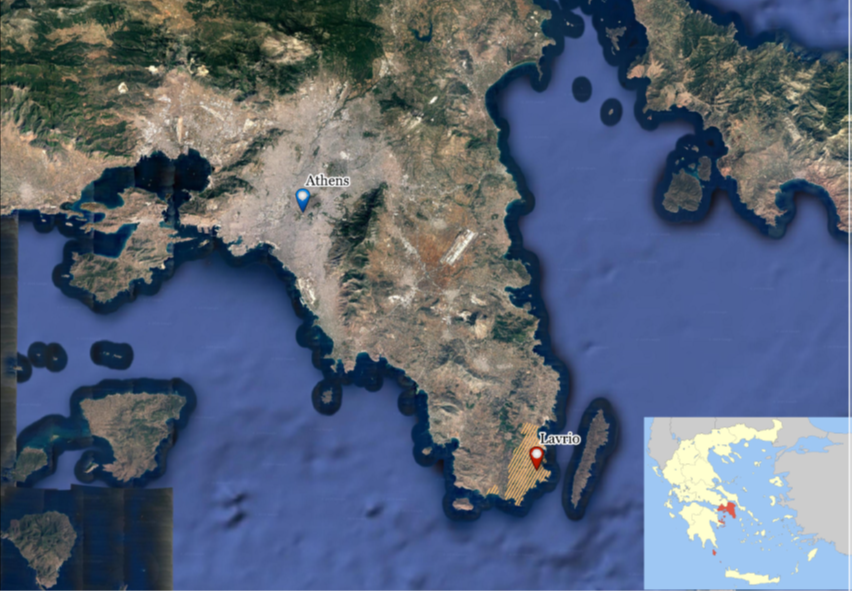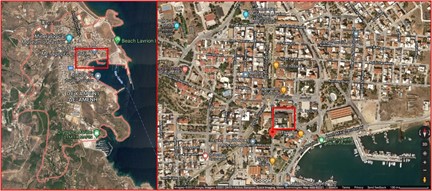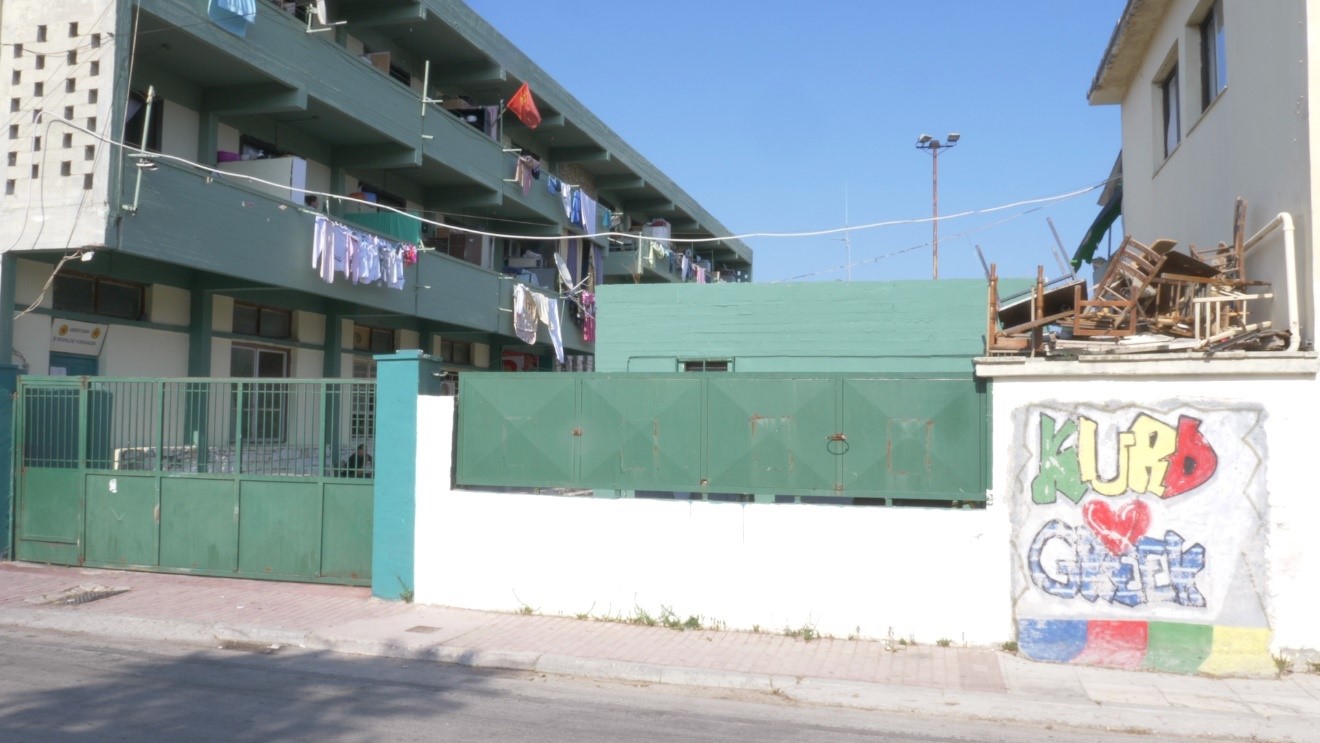The camp and the city: Insights from a multi-stakeholder community consultation in the port of Lavrio in Attica (Greece)
by Filyra Vlastou Aristotle University of Thessaloniki
Introduction and context
During June and July 2021, the Greek team carried out a set of multi-stakeholder community consultations (MSCC) in the port of Lavrio. The small town of more than 7,000 inhabitants in southern Attica had hosted three refugee camps until very recently: The former state-, now self-organised old Lavrio camp located in the very centre of the town since 1947, a makeshift campsite created in 2010 in Neraki, an area about one kilometre away from the town, and the official camp of Lavrio (located at neaby Sounio), founded in 2017 and closed in June 2021, located approximately five kilometres outside the town. The old Lavrio camp, located right in the heart of the town—around the corner from the central square, next to the police station and just five minutes’ walk from the Town Ηall—is the first state camp for political refugees in Greece. It was founded in 1947 by the national authorities to shelter refugees fleeing from the communist regimes of that time. To this day, the camp accommodates displaced people. For the last 35 years, its population has mostly consisted of (initially) Turkish and (lately) Kurdish political exiles, many of whom are members or/and sympathisers of the Kurdistan Workers’ Party (PKK). Almost since its foundation and until recently, the camp was run by the Red Cross. After 2010, disputes emerged between the Red Cross and the government, among others, over funding. In 2016, following the refusal of residents to abide with the authorities’ demand to ‘de-politicise’ the camp by taking down all symbols, posters and images defining it as a political space and move to other facilities, the Greek government abandoned the site. From then on, the camp became self-organised and hosted approximately 400 asylum seekers, migrants and refugees—the majority of whom were Kurds from Syria, but also from Turkey, Iraq and Iran, as well as a small group of Afghans. The length of time people stay there is between a couple of months and a few years. The campsite in the area of Neraki was created by the authorities in 2010. A number of containers were put in an empty delimited field on the outskirts of the town to shelter some of the residents of the old camp while some of its buildings were being repaired. However, following the refusal of residents to be transferred, Neraki camp stayed empty. That changed in 2015, when following the increase of displaced people’s arrivals in the country, the old Lavrio camp exceeded its capacity and some of its residents moved there voluntarily. Today, the campsite is an “extension” of the old Lavrio camp, hosting some more than 100 persons, in the majority Kurds.
The official camp of Lavrio, operated from 2017 to June 2021 in a forest area at facilities previously used as a summer camp for children, was founded in the region following the abandonment of the old camp by the state authorities. Before its closure, it hosted 235 people (43% children)—mainly from Afghanistan (33.2%) from Syria (29.8%) and from Congo (18.3%). In the absence of any facilities in the area, despite the distance, the camp residents visited the city of Lavrio for everyday needs (e.g. health issues, shopping groceries etc).

It is important to mention that the town of Lavrio itself is widely known as a city of migrants, not only due to the presence of the camps but mainly because of its own past. Lavrio is a relatively new town. It was created in the 1870s, after an Italian entrepreneur established a mining company on an empty plot and and Greek and foreign migrants moved there to work in the mines. Soon, the city expanded, becoming an important industrial centre, which throughout the 20th century was a focal point for migrants and refugees seeking employment. Lavrio remained an industrial town until the early 1990s, when it experienced harsh de-industrialisation, causing an unemployment rate of 70 per cent. Today, the town is reliant on tourism and other services to survive.

Location of Lavrio in Attica, the town centre (left) and the camp (right)
Our previous TRAFIG-related research in Lavrio already revealed the complexity of relations between camp residents and the local society. The location of each camp, their presence over time, the profile of their residents in terms of ethnicity and legal status and the specific social and economic relations developed over time shape the attitudes of members of the local community towards these camps and the displaced people inhabiting them. For instance, residents’ associations saw the newly founded (albeit short-lived) official camp of Lavrio, located in the heart of a forest area, as a threat to the surrounding area. Several testimonies from such associations (whose members in their majority are owners of summer residences in the area), revealed that they feared that camp residents might cause fires or/and destroy the green environment on purpose. On the other hand, the old Lavrio camp, located in the very centre for more than 50 years, has been part of the city’s identity as many locals have noted. Yet, its very location in a period when local authorities’ vision is to turn the former industrial town into a seaside tourist stopover for yachts makes it highly disputed and contested.
Aims, process, participants and key outcomes
The overall aims of the multi-stakeholder community consultations in the town of Lavrio was to better understand the relations between the members of the local community and those living in the camps and to discuss possible solutions to the problems identified by the participants. All our participants referred to the old Lavrio camp and the Neraki campsite, as in reality, both camps formed one large entity being, in fact, the same community with strong bonds and relations. We decided, therefore, to disregard the particular aspects of the Neraki locality in the present MSCC.
COVID-19 pandemic-related precautions and restrictions did not allow us to have one large event. So, despite our original intentions and the project goals, we decided to host several subsequent meetings/interviews. Another reason for this decision was the potential danger of bringing people with conflicting interests together, exacerbating already existing tensions in the current sensitive period, characterised by increasingly restrictive policies against displaced people in the country. We, therefore, sought instead to give a voice to various stakeholders living in the town of Lavrio who represented the local authorities, civil society and the camp community, as well to speak with members of the local society in key positions (school, health center), grouping some of them around the same table. To this end, the team held two separate meetings: a first one with the respective mayors in office at the time (from 2002 to 2010 and from 2014 to present), a former mayor (from 1995 to 2002) and two members of the administration of the Lavrio Port Authority; and a second with the headmaster of a local public primary school and a general practitioner employed in Lavrio’s Health Centre—the only public health facility in the town. In addition to these meetings, we also conducted two interviews: one with the NGO Homespot based in Lavrio since 2016, which provides humanitarian assistance to displaced people in both the informal and official camps; and one with the Coordinator of the Kurds’ Committee in the old Lavrio camp and responsible for the Cultural Association of Kurdistan in Greece. These interviews and meetings were scheduled for between late June and early July 2021.
 Michalis Kastanidis, July 2021, Outside view of the old Lavrio camp. In the wall a graffiti states: Kurd love Greek
Michalis Kastanidis, July 2021, Outside view of the old Lavrio camp. In the wall a graffiti states: Kurd love Greek
Before the discussions took place, the interviewers had developed a guide to support the discussions. Questions to be asked concerned the relation of each stakeholder group with the camps and their residents, the particular characteristics of the two camp localities, the social relationships between locals and camp residents, the economic “footprint” of the camps but also of their people and whether this is related to a more general vision for the economic development of the town. The guide was adapted according to participating stakeholders. The methodology was inspired by the timeline focus group method guidelines (also used in the TRAFIG fieldwork), according to which the interviewers asked the participants to emphasise the changes and mutations they observed over time. In what follows, a summary of the three key issues that were raised during the interviews and the meetings is presented below:
- Long-term residents stressed structural factors affecting their relationship with displaced people, including the state’s deficiency or unwillingness to appropriately staff key public institutions such as the school and the one and only health centre of the town to adequately address the increasing workload caused by the presence of displaced people. For instance, the lack of interpreters in these key public institutions complicates and undermines communication and creates unnecessary tensions and fights. Problems of communication because of the lack of interpreters, it was mentioned, may be a factor why displaced people are unwilling to send their children to school. Also, the replacement of AMKA (National Insurance Number) with PAAYPA (Foreigner’s Temporary Insurance and Health Coverage Number), which added more obstacles to already exisiting bureaucratic procedures, deprived many displaced people of the chance to have themselves vaccinated in the context of the pandemic, generating perceptions about the camps as a health threat for the town. In general, contacts mentioned that the situation was easier in the official camp of Lavrio, due to the mediation of humanitarian actors active in the camp.
- The local authorities’ vision (mayor, port authorities) is to turn the town of Lavrio into a hub for “upstream” high added value economic activities, as well as a tourist destination. “In this vision, refugees are not included” stressed the mayor. Local authorities explicitly said that they want the old Lavrio camp to be closed “as we closed the official camp of Lavrio”. In their view, its central location increases the visibility of its residents and hinders the town from capitalising on its privileged location. They argued that, first, tourists do not want to see refugees moving around the city. Second, since the old camp ceased to be official and, therefore, locals stopped working in it, the local society would be more receptive to its closure as there is no direct profit.
- In response to these arguments, the Coordinator of the Kurds’ Committee in Lavrio camp noted that tourists “always stop before the camp and want to learn about us, asking how they can be helpful”. As far as the vision is concerned, he said that this is only the local authority’s “capitalist vision”, which does not reflect the perceptions of the local society. This is supported by a number of testimonies from long-term residents that show this cleavage between the local authorities and the local society. The local society is “tolerant, welcoming displaced people”, as one of our participants said (the general practicionner), what in his opinion proves why “the camp was never an issue at stake in local elections”. An initiative called Lavrio Refugee Support Committee has been actively supporting the refugees for years, publicising the problems of camp residents, demanding solutions from the local authority, facilitating communication with the local community (Dirakis, 2019) and networking with local, translocal and transnational organisations.
Concluding remarks
Currently, we observe a proliferation and multiplication of spaces of encampment in Europe and globally. Over half of the migrants stranded in Greece since 2015 are confined in camps and camp-like spaces, usually located in isolated and segregated areas at the peripheries of cities or even far beyond. The case of the old Lavrio camp is a positive exception.
- Its central location allows many daily micro-economies and transactions between the camp and the city. Every day many camp residents wait outside its main entrance to be picked by locals for casual employment around the area. Some others work in the nearby shops, restaurants, or the marina. Besides, as the Coordinator of the Kurds’ Committee in the old Lavrio camp put it: “the residents of the camp live just like all the other locals: We have our micro-jobs, we shop, we drink our coffee, we walk along the seaside”.
- Although the temporary stay of many of the camp residents does not leave room for many meaningful contacts, the long-term presence of the camp itself seems to allow locals to familiarise themselves with the “other”, an important aspect of intergroup relations.
- The fact that the camp is self-managed gives it a community character that allows its inhabitants autonomy and the development of strong networks. Simultaneously, as the MSCC has also shown, this community character adds to the “tensions” with the local community, which are related to the camp’s location in the centre of the town. The camp residents and their networks are aware of the “tensions” and the importance of addressing them. In our discussion, the Coordinator of the Kurds’ Committee in Lavrio concluded: “Some years ago, the Caravan of Solidarity from France brought to the town some medical equipment that cost close to 15,000 euros. We donated them all to the medical centre of Lavrio; we also do things for the town”.
Reference: Dirakis, Y. (2019) “Claiming the right to the camp – An ethnography of the squatted Lavrio Center of Temporary Stay for Foreign Asylum Seekers” [Unpublished master’s thesis]. Maastricht University, United Nations University, Maastricht.
The views and opinions expressed in this blog do not necessarily reflect the opinion of the TRAFIG Consortium or the European Commission (EC). TRAFIG is not responsible for any use that may be made of the information contained therein.